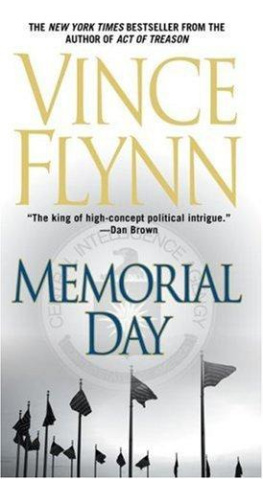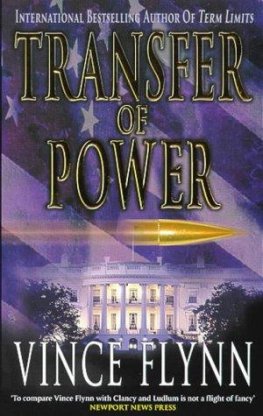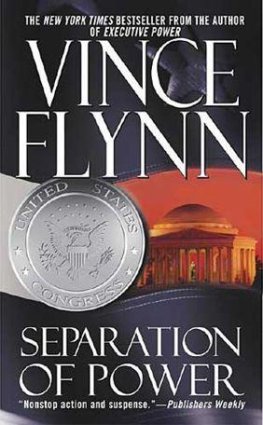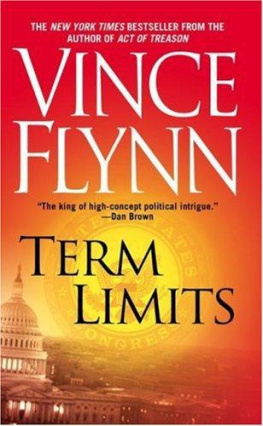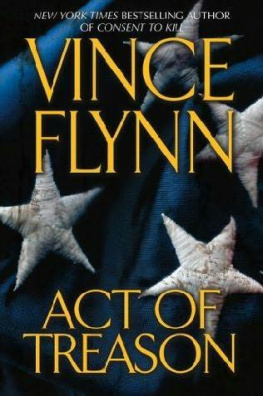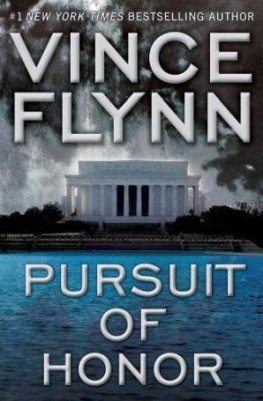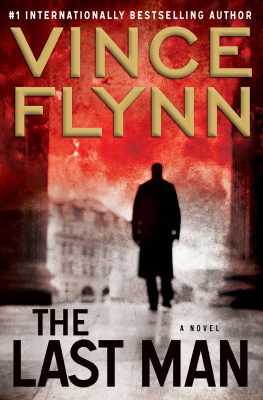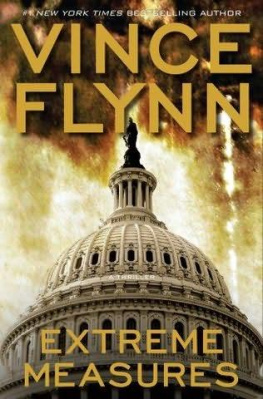TRANSFER
OF POWER
VINCE FLYNN
Out of respect for the United States SecretService and the security of the president, certain facts regarding the layoutof the White House and Secret Service tactics have either been changed oromitted.
WASHINGTON, D.C.
A fine mist fell from the darkening springsky as the black limousine turned off of E Street. The armor-plated car weavedthrough the concrete-and-steel barricades at a speed suggesting urgency. As thelimousine turned onto
West Executive Drive, it slowed briefly for the heavyblack gate to open, and then sped forward. After splashing through severalpuddles, the limo came to an abrupt stop in front of the ground-floor entranceto the West Wing of the White House.
The rear passenger door opened immediately,and Dr. Irene Kennedy stepped from the car. She walked under the long off-whiteawning that extended from the building to the curb and paused to let her bosscatch up. Thomas Stansfield slowly climbed out of the limo and buttoned thejacket of his charcoal gray suit. At seventy-nine years of age Stansfield wasan icon in the intelligence community. His career dated all the way back toWorld War II and the OSS,the precursor to the CIA. Stansfield had been one of Wild Bill Donovansrecruits almost sixty years earlier a different war fought by a different freed.Stansfield was the last one. Now they were all gone, retired or dead, and itwouldnt be much longer before he turned over the reins of power at themuch-maligned and embattled intelligence agency.
The CIA had changed during his tenure. Moreprecisely, the threats had changed, and the CIA was forced to change with them.The old static days of a two-superpower world were long gone, replaced by smallregional conflicts and the ever-growing threat of terrorism. As Stansfieldclosed out his career, this was what bothered him most. The threat of oneindividual bringing biological, chemical, or nuclear annihilation to Americawas becoming more and more plausible.
Stansfield looked up at the lazy mist thatwas falling from the early evening sky. A light spray dusted his face, and thesilver-haired director of the CIA blinked. Something was bothering him, and hecouldnt quite put his finger on it. Stansfield gave the darkening sky one lastlook and then stepped under the awning.
Kennedy continued through the double doors,where two uniformed Secret Service officers were standing post, and starteddown the long hall. This was the first floor of the West Wing. The presidentsoffice was located on the floor above, but that was not where they would bemeeting. Irene Kennedy sped ahead, while Stansfield followed at his always evenpace.
Down the hallway, on the right, a U.S. Navyofficer stood in his cleanly pressed black uniform with his hands claspedfirmly in front of him. Good evening, Dr. Kennedy. Everything is ready. Thegenerals and the president are waiting for you. The watch officer of the WhiteHouse Situation Room gestured to his left.
Thank you, Commander Hicks, repliedKennedy as she walked past the naval officer.
They went down several steps, took a right,and came to a secure door with a camera mounted above it. To the left was ablack-and-gold plaque with the words White House Situation Room: RestrictedAccess.
The lock on the door buzzed, and Kennedypushed the door open. She entered and turned to her left, into the SituationRooms new conference room. Director Stansfield followed her, and CommanderHicks closed the soundproof door behind them.
President Robert Hayes, dressed in atuxedo, stood at the far end of the room and listened intently to the two menin front of him. The first, General Flood, was the chairman of the JointChiefs. Flood was six four and weighed almost two hundred seventy pounds. Thesecond man was General Campbell, a half foot shorter than his superior and onehundred pounds lighter. Campbell was thecommander of the U.S.militarys Joint Special Operations Command, or JSOC. Before taking his mostrecent job, he had proudly commanded the famous 82nd Airborne Division and the18th Airborne Corps.
President Hayes had been in office for onlyfive months, and thus far had a decent working relationship with both thePentagon and the CIA. Before being elected president, Robert Xavier Hayes hadserved as both U.S.congressman and senator. The Democrat from Ohio had been elected to the highest officein the land largely because he had a very clean personal life and was seen assomeone who could mend the ever-deepening divide between the two parties. Theprevious administration had been rife with scandal, so much so that theAmerican people had overwhelmingly picked someone whose personal life couldpass the rigorous scrutiny of the press. Hayes was happily married and hadthree children in their thirties, all of whom had managed to stay off thetabloid covers and live relatively normal lives.
Kennedy set her briefcase on a chair nearthe end of the long table and said, If everyone will be seated, we can getstarted. She felt rushed. Things were coming together at a frantic pace.
Director Stansfield greeted the twogenerals and the president. No one was in a talkative mood. The presidentworked his way around to the opposite end of the table and sat in his high-backedleather chair. All four walls of the room were covered with dark wood except asquare section behind the president. That portion of the wall was white, and inthe middle of it was the circular seal of the president of the United States.
With the president at the head of thetable, the two generals sat on his right and Director Stansfield on his left.Kennedy handed each of the men identical folders that were sealed with red tapeand marked Top Secret.
Please feel free to open the files while Iget the rest of the materials ready. Kennedy pushed some of hershoulder-length hair behind her ear. After several seconds of digging throughher briefcase, she found the right disk and inserted it into the A drive of thecomputer under the podium. About sixty seconds later the director of the CIAs CounterterrorismCenter was ready to start.
A map of the Persian Gulf appeared on thelarge screen to Kennedys right, and she began, Mr. President, four days agowe inserted one of our people into the Iranian city of Bandar Abbas. Our man was operating on someinformation he received that Sheik Fara Harut might be in the city. Kennedypressed a button, and the screen changed from the map to a grainyblack-and-white photograph of a bearded man in a turban. Fara Harut, shownhere in this 1983 photograph, is the religious leader of the militant Islamicgroup Hezbollah. He has very strong ties to the religious conservatives in Iran.Kennedy glanced sideways at the president and added, You may have noted somemention of him in the PDB. Kennedy was referring to the Presidents DailyBrief, an intelligence summary given to him every morning by the CIA.
The president nodded. I recall the name.
Kennedy pressed a button, and a new photoappeared on the screen, this time of a much younger, clean-shaven, and handsomeindividual. This is Rafique Aziz. It was taken in the late seventies, whenAziz was obtaining a degree in electrical engineering from AmericanUniversityin Beirut.
The president nodded reluctantly and said, Iam definitely familiar with this individual.
Kennedy nodded. Well, you might not befamiliar with this most recent development. The doctor pointed to the screenat the front of the room, and a series of photos played out showing charredbuses and grotesque, bloody bodies. These bombings have all been linked to thefundamentalist Palestinian group Hamas. Hamas has stepped up its attacksrecently in an effort to derail the Middle Eastpeace process. Hezbollah and Hamas have done very little to help each otherscauses. Kennedy looked down the long table and added, That is, untilrecently. Aziz and Harut have been looking for a way to continue their fight asthings have calmed in Beirut.They found their opportunity after Israel assassinated Hamas leaderYehya Ayyash in 1996. Hamas turned even more militant, stepping up its effortsto drive Israel from the West Bank and Gaza Strip. In this most recent period, theIsraelis have noted a marked increase in the sophistication of Hamas bombs andtactics. It is our belief that Rafique Aziz is responsible for this. Kennedypaused and got ready to drop the bombshell. To make matters even worse, wehave also learned that Saddam Hussein has offered to help fund some of thegroups actions.
Next page

